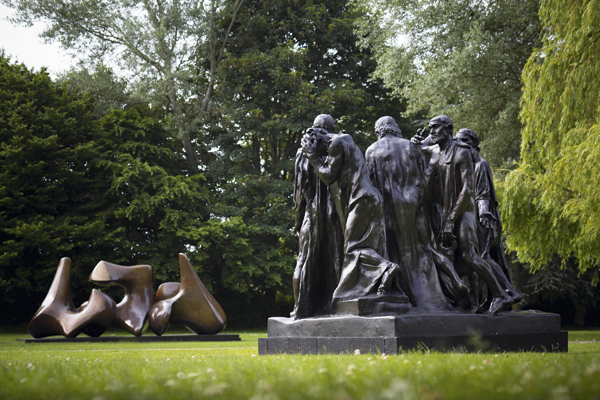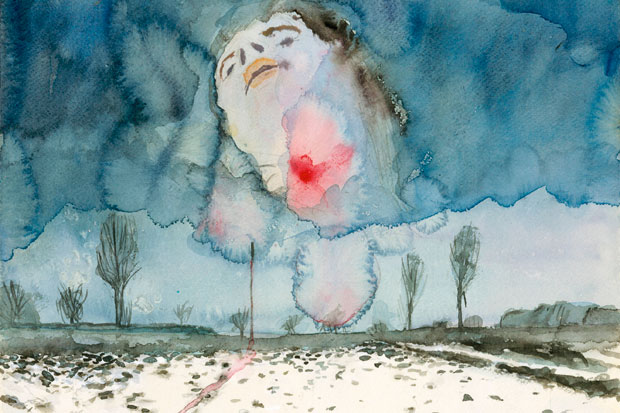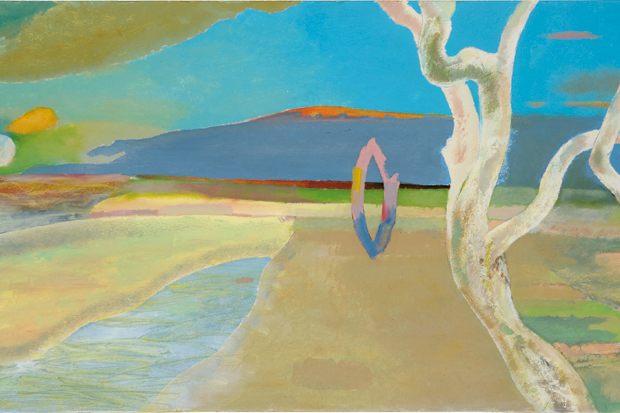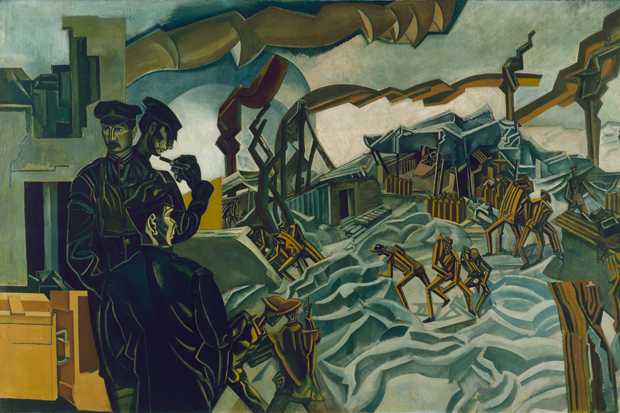One generation is usually so busy reacting against its predecessors that it can take years for a balanced appreciation of real and relative merits to emerge. Henry Moore was born in 1898, and Rodin didn’t die until 1917, but they never met. All his life Moore was aware of Rodin’s work, and although early on he made apprentice works influenced by Rodin, it was only when he had established his own territory as an artist that he could afford to look long and admiringly at the senior artist. Indeed, Moore came to value his work so highly that he included four sculptures and three drawings by Rodin in his own collection and was happy to be consulted over the installation of the great Rodin exhibition at the Hayward Gallery in 1970. The current exhibition — the first time the work of another has been shown beside his own in Moore’s old home at Perry Green — tellingly juxtaposes sculptures and drawings by both artists in landscape and gallery settings.
Any visit to the Moore Foundation is incomplete without a tour of Hoglands, the old farmhouse in which the sculptor lived with his wife Irina and daughter Mary. In later life, Moore added a large entertaining room to the original house where he could show off his own work to prospective buyers (he was his own agent), and display his increasingly distinguished collection. The ground-floor interiors are largely unchanged. Here, for instance, are three paintings by Courbet including a seascape, a large Vuillard and a tiny Renoir of roses, together with an Ivon Hitchens still-life. In the small sitting room at the front of the house are drawings by Daumier and a painting by Sickert entitled ‘Yellow Skirt’. In the office is a large and beautiful Degas drawing of a nude and a fine ink portrait of Rodin by William Rothenstein. In the dining room, accompanying a colourful collection of china, are another substantial Vuillard, a little painting of magnolia flowers by André Masson and a strong portrait of Moore’s mother by his friend and contemporary Raymond Coxon. The intimacy and naturalness of the house are enchanting.
Out in the grounds, the first sculpture to register is Moore’s ‘Upright Motive No 8’, from 1955–6, a bony totem that seems to combine crucifix with stringed instrument and knuckle joint. This leads us down the garden to Rodin’s sumptuous ‘Cybele’ (1905), a typically fragmentary figure (no head, only one arm), but with that sensual flow of movement that characterises so much of Rodin’s work. Here he differs radically from Moore, who saw sculpture as a static mode, intended to convey weight and seriousness without the distractions of movement.
Yet it would be a great mistake to think that there is no vitality to Moore’s solid forms. He may have renounced the overt evocation of movement but his work is full of sculptural rhythms and profound understanding of the human body, the very things he admired in Rodin. As he admitted, Rodin taught him a lot about the body, and particularly ‘its asymmetry from every point of view’. Moore also quoted Rodin as saying that sculpture was the art of the hole and the bump, which sounds rather like a description of his own work.
Both artists were interested in metamorphosis, with bringing apparently unrelated forms together and investigating the relationship of sculpture to its surroundings. Thus to see a group of Rodin’s figures with an equal complement of Moore’s is not just a chance to compare and contrast, but also to consider how each dealt with the human form in a landscape context. Look at the way in which the vast hammer-toed feet of Rodin’s ‘Adam’ grip the earth, his bulging calves matching the corded muscles of his huge forearms. Nearby is Moore’s ‘Three Piece Sculpture: Vertebrae’, the internal forms of which frame the landscape (and particularly the trees) intriguingly. Here too is Rodin’s great ‘Burghers of Calais’, this cast on loan from the gardens by the Houses of Parliament where it is a much-loved landmark, commemorating an actual event of 1347 during the Hundred Years War. This remarkable group makes up a dance of lamentation, each figure separately conceived and constructed then brought together in a circle of heroic self-sacrifice, the men wearing rope halters and carrying the keys of the town to the besieging English king.
There are several more beautiful sculptures outside, including Rodin’s ‘Fallen Caryatid with Stone’ and ‘Eve’, but the remainder of the exhibition is indoors, in the large gallery at the far end of the garden. This is full of fine things offering splendid juxtapositions: one cabinet containing Rodin’s ‘Cathedral’, Moore’s ‘Mother and Child: Hands’ and Rodin’s ‘Study of a Clenched Hand’. There are great single pieces, such as Rodin’s third ‘Gates of Hell’ maquette and a small version of his majestic ‘Balzac’, Moore’s ‘Draped Torso’ inspired by ancient Greek art and ‘Two Piece Points: Skull’. There are erotic watercolours by Rodin, monumental ones by Moore, and upstairs a close look at both artists as collectors. All in all, a great deal to see and ponder.
A well-illustrated catalogue (£17.50 in paperback) is an excellent souvenir of the exhibition, containing useful essays and introductory text. If you don’t manage to get to Perry Green before the show closes, it will be on view again next year at Compton Verney in Warwickshire (15 February to 31 August). The two sculptors look very good together: they are sufficiently different, yet with enough common ground, to establish formal dialogues that intrigue and stimulate.
A word about opening times: the Moore Foundation is open only Wednesday to Sunday, 11 a.m. to 5 p.m., and most of the larger sculpture is in the open air, so fine days are preferable for a visit, though there is always plenty to see in the various exhibition buildings. There is nowhere quite like Hoglands: here one encounters the heart and main sources of inspiration of Moore’s unique achievement. If you are travelling by car and can find your way by circuitous country lane from the hamlet of Perry Green to nearby Much Hadham, a visit to St Andrew’s Church is highly recommended. There you will see two Corsham stone heads carved by Moore in 1953, a Queen and a King, as the label-stops for the exterior of the West Door. Above the door (and best seen from inside the church) is a marvellous stained-glass window by Patrick Reyntiens (born 1925), based on a Moore etching of trees. The more I see of Reyntiens’s work (he is best known for his stained-glass collaborations with John Piper, such as the great Baptistery window at Coventry Cathedral), the better it looks. If ever an artist deserved proper assessment, it is Reyntiens: his contribution to the art of the past 60 years has been much undervalued.
Got something to add? Join the discussion and comment below.
Get 10 issues for just $10
Subscribe to The Spectator Australia today for the next 10 magazine issues, plus full online access, for just $10.
You might disagree with half of it, but you’ll enjoy reading all of it. Try your first month for free, then just $2 a week for the remainder of your first year.














Comments
Don't miss out
Join the conversation with other Spectator Australia readers. Subscribe to leave a comment.
SUBSCRIBEAlready a subscriber? Log in